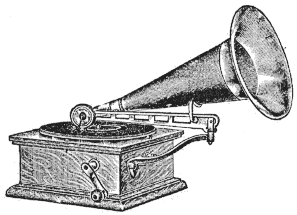Emile Berliner
Today, a not-so-old book -- in a forgotten tongue. The University of Houston's College of Engineering presents this series about the machines that make our civilization run, and the people whose ingenuity created them.
Young Emile Berliner emigrated to America in 1870. In 1877 his invention of the microphone transformed the new Bell telephone. Eleven years later his recording system replaced Edison's new cylindrical phonograph.
I've just read F.W. Wile's biography of Berliner. He wrote it in 1926, in a prose style no one uses today. The new communications media, helped along by Berliner's contributions, put an end to that old rhetoric. Listen to Wile's florid account of how nineteen-year-old Berliner left Germany for America:
Defoe and Fenimore Cooper ... played a subtly vital part, with their classic narratives of self-reliance ... in preparing Emile Berliner for the eventful life about to open up for him in a distant clime ... He mounted the gangplank ... and Germany was bereft of a genius.
Berliner certainly was a bright kid poised for adventure. By 1875 he was working in Washington, D.C., as lab assistant to one Dr. Fahlberg, who discovered saccharine. At nights, Berliner studied physics on his own.
A year later Bell invented the telephone. When Berliner heard about that, he was excited. He didn't yet understand Bell's creation, or how imperfectly Bell was converting sound waves to electric current. He just wanted to make his own telephone.
Within a year he'd found that, by varying the pressure on an electrical contact, he could send a continuously varying signal. He invented the microphone. Years of dreary patent-law combat followed as he and Bell and Edison circled and vied for priority.
Next Berliner followed up on another great invention. In 1886 Edison patented his phonograph. He used a needle vibrating in and out of a groove wound around a cylinder. Two years later, Berliner perfected the familiar system with a needle vibrating side-to-side in a groove on a flat phonograph record. Out of that grew the Victor Talking Machine Company.
By 1926 Berliner's little dog, listening to his master's voice, could be found in most American homes. By 1926 we were processing over 50 million phone calls daily, and the vocabulary of our communication rhetoric was shifting. 1926 was the same year Hemingway published The Sun Also Rises. The Nobel Literature Prize later called out Hemingway's simple prose as "style-making mastery of the art of modern narration."
In 1926 Wile finished his biography with a fine bit of doggerel: "Thus ... by teaching humility to its disciples, Science assumes the role of a most potent religion."
That's no Hemingway sentence. It's very far from the streamlined prose of a new information-dense world. It's no longer the way we spoke, or thought -- after the likes of Emile Berliner.
I'm John Lienhard, at the University of Houston, where we're interested in the way inventive minds work.
(Theme music)
Wile, F.W., Emile Berliner: Maker of the Microphone. Indianapolis: The Bobbs Merrill Company, 1926.

Clipart
An Early Berliner-Style Phonograph